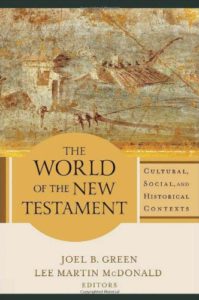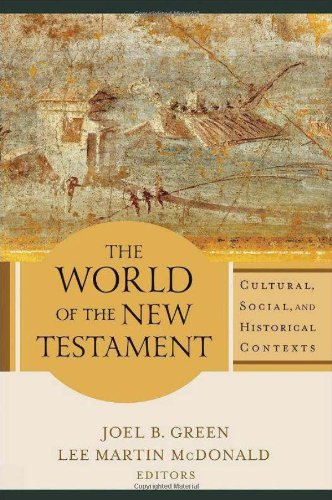 This week’s Book Review is The World of the New Testament, ed. by Joel Green and Lee McDonald (Baker Academic, 2013).
This week’s Book Review is The World of the New Testament, ed. by Joel Green and Lee McDonald (Baker Academic, 2013).
The World of the New Testament is a collection of forty-some introductory articles to different areas of New Testament background. The chapters are written by senior scholars in the field, such as the editors, J. Charlesworth, M. Bird, G. Green, and more. The articles are concerned with the historical background of the New Testament, with some consideration to literary features of the writings, but are not concerned with the theology espoused within them.
The work starts with an essay on New Testament chronology and then follow five sections: (1) Exile and Jewish Heritage; (2) Roman Hellenism; (3) Jews in the Context of Roman Hellenism; (4) Literary Context of Early Christianity; (5) Geographical Context of the New Testament. Each of the articles span about ten to twelve pages and contain helpful charts and pictures. I appreciated that this volume focused on providing most of the relevant primary evidence and spent less time on the secondary literature, so this volume is not only helpful for students, but for pastors or scholars who want a quick reference of primary sources in any certain area.
This textbook would be useful in a New Testament classroom. The fifth section alone would be an enormous help to new students to become acquainted with the geography and history of various regions prominent in the New Testament (e.g., Egypt, Palestine, and Galatia). The fourth section will help students to better understand how to read the New Testament as first-century literary products (e.g., the distinctive features of letter writing and pseudonymity), while the first three sections provide necessary historical information for understanding the New Testament in its fullness.
The distinctive historical orientation of this book differs from other New Testament textbooks that focus more on theology (e.g., Theological Interpretation of the New Testament) and from the more standard textbooks that cover historical, literary, and theological issues (e.g., Carson & Moo’s Introduction to the New Testament or Brown’s Introduction to the New Testament). It is therefore more properly a backgrounds work, not an introduction textbook, and if used for a New Testament introduction class it would need to be supplemented with some theological analysis.
There are some biases in the work that one would want to be aware of, some of which I cover here in my fuller review. Nevertheless, I would highly recommend the use of this book personally or in the classroom. You can preview or buy it on Amazon here.

